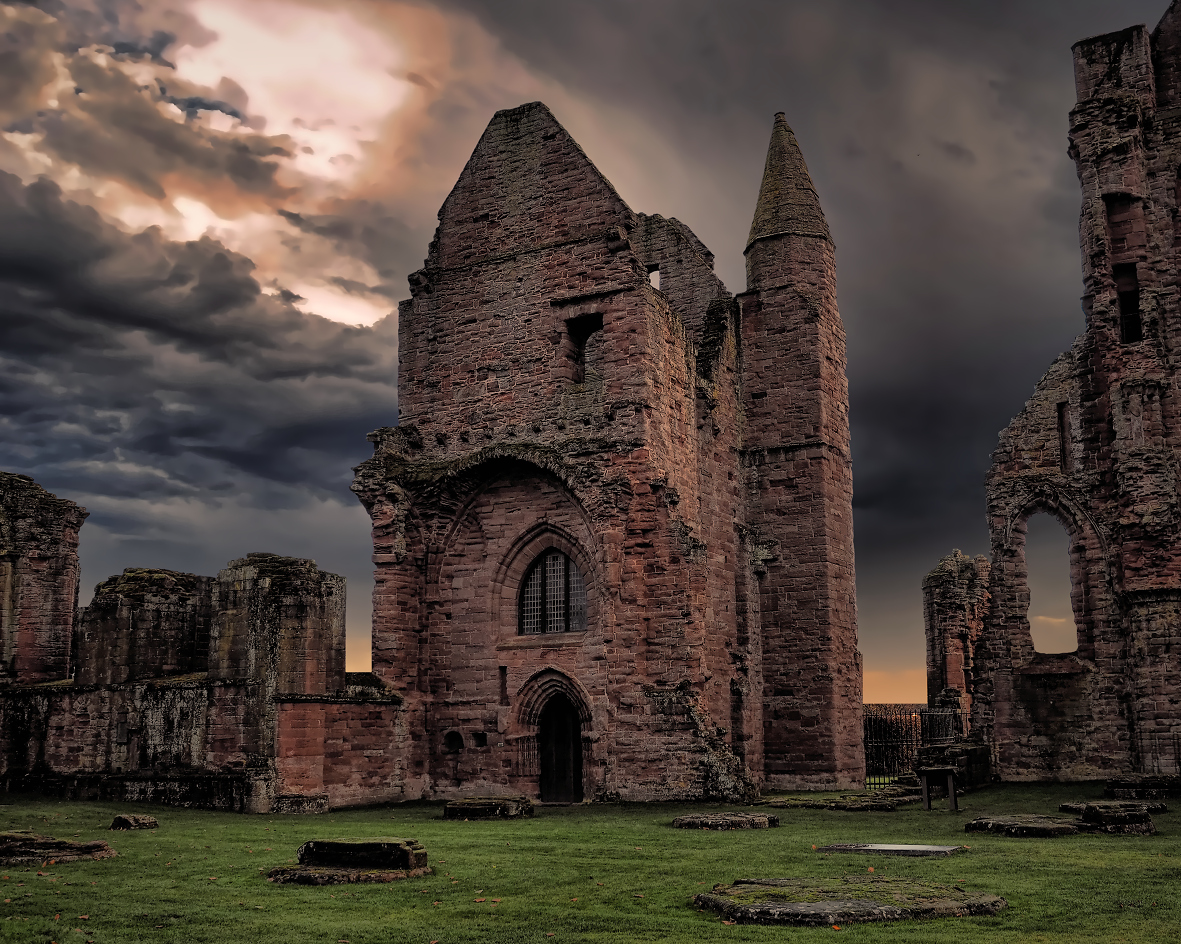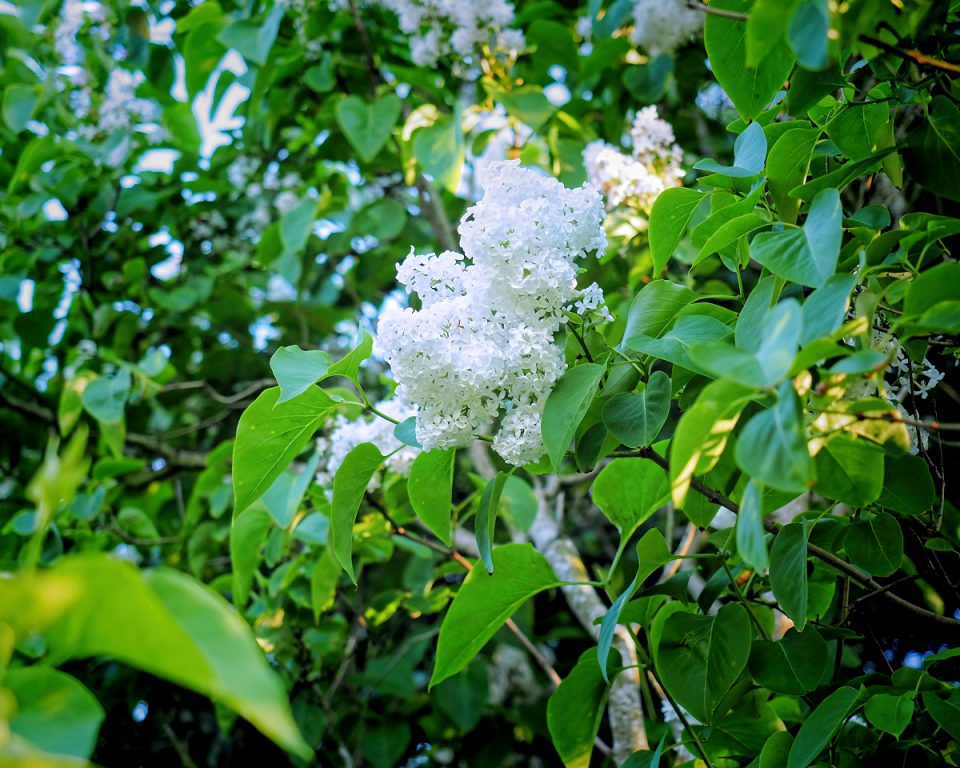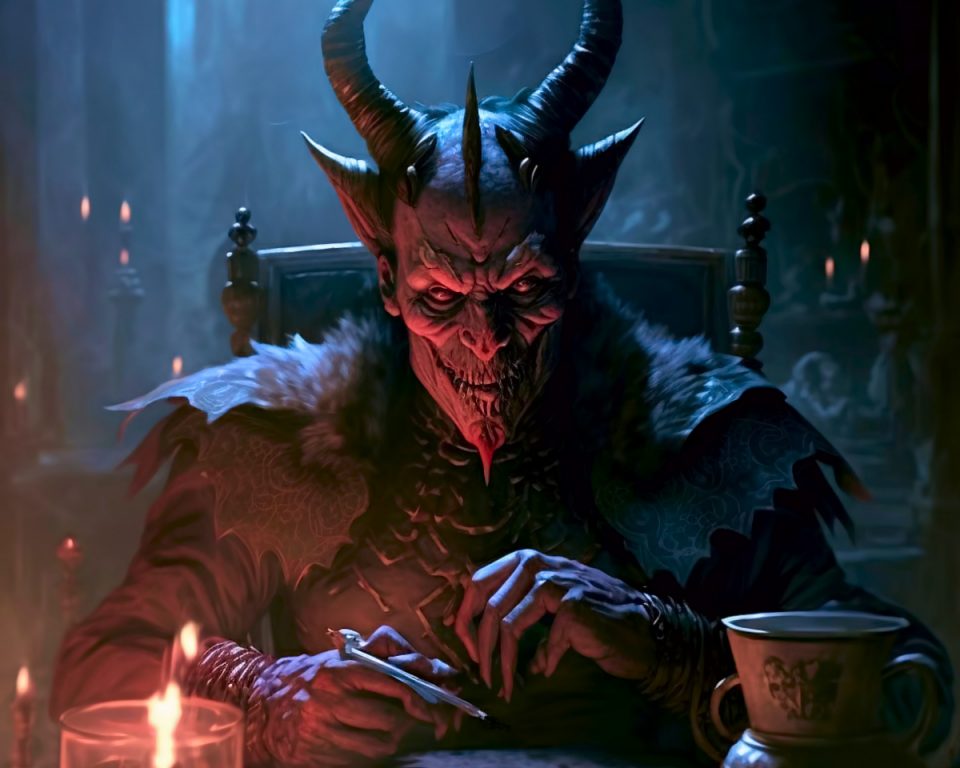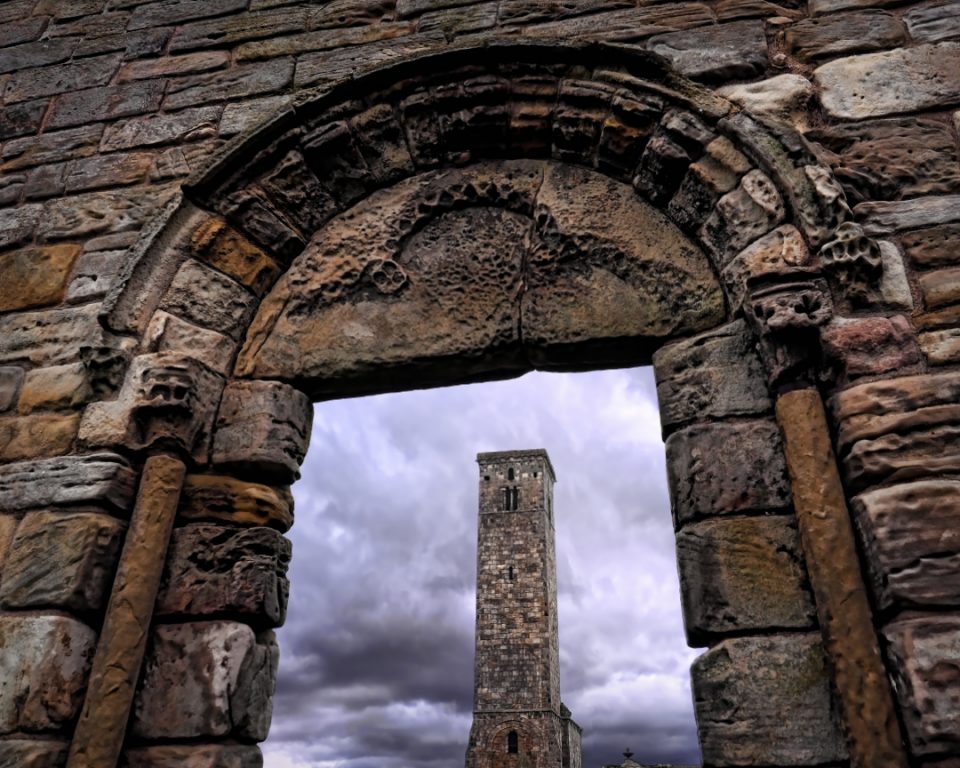The Declaration of Arbroath was signed on the 6th of April 1320. Robert the Bruce and a retinue of earls and knights met at Arbroath Abbey to sign the historic document. Not only was this most likely the most important document ever to be signed in Scotland but the ramifications of its ideals were to echo down through time and across continents. Perhaps today the Abbey is famed for this event, yet there is far more to Arbroath Abbey’s imposing ruins than meets the eye.
Arbroath Abbey was built by a king as a memorial to his murdered friend. A king was buried here. Once it housed the relics of Saint Columba and could boast of being one of the richest Abbeys in Scotland. A battle was fought beneath its shadow. It was struck by lightning and ravaged by the Reformation. It was once home to the infamous Cardinal Beaton.
Then when it seemed that its glory days were over, the Abbey hit the headlines in 1951, when the Stone of Destiny, Scotland’s ancient coronation stone, turned up next to the site of the High Altar. Then there are tales of mysterious bumps and thumps which come from unoccupied areas within the Abbot’s House and those who say the Sacristy is haunted.
The Origins of Arbroath Abbey
William I, King of Scots built Arbroath Abbey as a memorial to his childhood friend, Thomas Becket. The two had become firm friends when William visited the English Court. Thomas later became the archbishop of Canterbury. This promotion set him on a collision course with Henry II of England. In 1170, Thomas was assassinated at Henry’s instigation.
Later Henry was to regret his actions and in 1174 made public penitence for his part in the murder. Meanwhile, at that precise moment in time, William had invaded England and was captured at the Battle of Alnwick. William saw this as a sign that his dear friend was not pleased with his aggressive action and that he had incurred divine wrath. William would make amends by building Arbroath Abbey.
However, first, he had to be released. William was forced to sign the Treaty of Falaise, which stated that Henry was his feudal superior. There had been some contention over this, dating back to Anglo-Saxon times. The Scottish Kings owned lands in England, for which they were required to pay homage to the English crown. Conversely, in the eyes of the Scots, these lands were a separate entity to the Scottish Crown estate. But now the English monarchy had official proof that they were indeed lords over Scottish royalty. They had it in writing.
Strangely, the signing of the Treaty would inadvertently result in some other events associated with the Abbey.
Building Arbroath Abbey, home to the Declaration of Arbroath
Upon his release, William set about building the Abbey. It was to be built on a grand scale. As a sign of his favour, William granted the Abbey with the Monymusk Reliquary, a casket which held the relics of St Columba. Eventually, it was carried into battle at Bannockburn.
Meanwhile Richard the Lionheart became King of England. He needed money to fund his adventures at the Crusades. He agreed to terminate the Treaty of Falaise for the sum of 10,000 silver marks. In 1214, William died and was buried at the East End of the building. However, the Abbey was still being built and was not dedicated for worship until 8 May 1233.
In 1272, a storm caused damage to the Abbey’s Towers, but this was nothing compared with the turmoil which would soon strike Scotland. In 1286, Alexander III, King of Scots, plunged to his death, over a cliff face during a mighty tempest and thus plunged his country into a war.
The Lead up to the Signing of the Declaration of Arbroath
An unfortunate series of events had left his granddaughter, Margaret of Norway, as his sole heir. The child was only three years old. Alas, she died en route from Norway. Several claimants to the crown came forward, quoting genealogies. In the chaos which ensued, the Scottish Magnates appealed to Edward I to arbitrate. Edward rubbed his hands with glee. He was a shrewd and ambitious man who had already conquered Wales. The English king declared that he was willing to arbitrate on condition that he was named Lord Paramount over Scotland. He appointed John Balliol as his puppet king.
‘Toom Tabart’ as Balliol became better known as an ineffectual leader. Balliol was asked to supply troops for Edward’s war against France. The Scottish nobility responded by forming the ‘Auld Alliance’ with France, a treaty which would force England to fight on two fronts if either Scotland or France were invaded. Edward then had himself pronounced King of Scotland in retaliation and seized Scotland’s strongholds and the Stone of Destiny.
The Scottish Nobility would not tolerate this. Heroes such as William Wallace and Robert the Bruce stepped into the arena. The invading English armies would be sent homewards. In a protracted series of battles, Scotland won back her castles.
The Declaration of Arbroath
Despite the Scottish decisive victory over King Edward II at the Battle of Bannockburn, June 1314, Edward would not relinquish the English claim to the overlordship of Scotland. Neither Edward nor the Pope recognised Robert the Bruce as King of Scots. As a result, the barons and the community of the realm of Scotland wrote a letter to Pope John XXII. It is a carefully crafted appeal designed to persuade the Pope to review his position to the long-running Anglo-Scottish conflict.
The Declaration made a number of points: that Scotland had always been independent, and therefore longer than England; that Edward I of England had unjustly attacked Scotland and committed atrocities; that Robert the Bruce had delivered the Scottish nation from this peril; and, most controversially, that the independence of Scotland was the right of the Scottish people, rather than the King of Scots.
The Impact of the Declaration of Arbroath
The stirring language of the Declaration of Arbroath, and its evocative sentiments of nationhood and freedom, suggest that this is an early expression of popular sovereignty. The prevalent idea in Medieval times was that a king had a divine investiture which meant that they were accountable only to God. However, the wording of the document suggests that government is contractual and that kings can be chosen by the community rather than by God.
Comparisons have been made between the Declaration of Arbroath and the US Declaration of Independence. This is significant as many of the signatories of the US Declaration have Scottish ancestry. With this in mind, in 1998, the US Senate passed a resolution stating that 6th April “has a special significance for all Americans, and especially those of Scottish descent.” As a result, 6th April has been designated Tartan Day in the USA.
The reason the Declaration of Arbroath was written in Arbroath is that its Abbot at the time, Abbot Bernard, was Robert the Bruce’s Chancellor.
Translation of the Declaration of Arbroath, 6 April 1320 (Translated from Latin)
To the most Holy Father and Lord in Christ, the Lord John, by divine providence Supreme Pontiff of the Holy Roman and Universal Church, his humble and devout sons Duncan, Earl of Fife, Thomas Randolph, Earl of Moray, Lord of Man and of Annandale, Patrick Dunbar, Earl of March, Malise, Earl of Strathearn, Malcolm, Earl of Lennox, William, Earl of Ross, Magnus, Earl of Caithness and Orkney, and William, Earl of Sutherland; Walter, Steward of Scotland, William Soules, Butler of Scotland, James, Lord of Douglas, Roger Mowbray, David, Lord of Brechin, David Graham, Ingram Umfraville, John Menteith, guardian of the earldom of Menteith, Alexander Fraser, Gilbert Hay, Constable of Scotland, Robert Keith, Marischal of Scotland, Henry Sinclair, John Graham, David Lindsay, William Oliphant, Patrick Graham, John Fenton, William Abernethy, David Wemyss, William Mushet, Fergus of Ardrossan, Eustace Maxwell, William Ramsay, William Mowat, Alan Murray, Donald Campbell, John Cameron, Reginald Cheyne, Alexander Seton, Andrew Leslie and Alexander Straiton, and the other barons and freeholders and the whole community of the realm of Scotland send all manner of filial reverence, with devout kisses of his blessed feet.
Most Holy Father, we know and from the chronicles and books of the ancients we find that among other famous nations our own, the Scots, has been graced with widespread renown. It journeyed from Greater Scythia by way of the Tyrrhenian Sea and the Pillars of Hercules, and dwelt for a long course of time in Spain among the most savage peoples, but nowhere could it be subdued by any people, however barbarous. Thence it came, twelve hundred years after the people of Israel crossed the Red Sea, to its home in the west where it still lives today. The Britons it first drove out, the Picts it utterly destroyed, and, even though very often assailed by the Norwegians, the Danes and the English, it took possession of that home with many victories and untold efforts; and, as the histories of old time bear witness, they have held it free of all servitude ever since. In their kingdom there have reigned one hundred and thirteen kings of their own royal stock, the line unbroken by a single foreigner.
The high qualities and merits of these people, were they not otherwise manifest, shine forth clearly enough from this: that the King of kings and Lord of lords, our Lord Jesus Christ, after His Passion and Resurrection, called them, even though settled in the uttermost parts of the earth, almost the first to His most holy faith. Nor did He wish them to be confirmed in that faith by merely anyone but by the first of His Apostles – by calling, though second or third in rank – the most gentle Saint Andrew, the Blessed Peter’s brother, and desired him to keep them under his protection as their patron for ever.
The Most Holy Fathers your predecessors gave careful heed to these things and strengthened this same kingdom and people with many favours and numerous privileges, as being the special charge of the Blessed Peter’s brother. Thus our people under their protection did indeed live in freedom and peace up to the time when that mighty prince the King of the English, Edward, the father of the one who reigns today, when our kingdom had no head and our people harboured no malice or
treachery and were then unused to wars or invasions, came in a guise of a friend and ally to harass them as an enemy. The deeds of cruelty, massacre, violence, pillage, arson, imprisoning prelates, burning down monasteries, robbing and killing monks and nuns and yet other outrages without number which he committed against our people, sparing neither age nor sex, religion nor rank, no-one could describe nor fully imagine unless he had seen them with his own eyes.
But from these countless evils we have been set free, by the help of Him who though He afflicts yet heals and restores, by our most tireless prince, King and lord, the lord Robert. He, that his people and his heritage might be delivered out of the hands of our enemies, bore cheerfully toil and fatigue, hunger and peril, like another Maccabaeus or Joshua. Him, too, divine providence, the succession to his right according to our laws and customs which we shall maintain to the death, and the due consent and assent of us all have made our prince and king. To him, as to the man by whom salvation has been wrought unto our people, we are bound both by his right and by his merits that our freedom may be still maintained, and by him, come what may, we mean to stand.
Yet if he should give up what he has begun, seeking to make us or our kingdom subject to the King of England or the English, we should exert ourselves at once to drive him out as our enemy and a subverter of his own right and ours, and make some other man who was well able to defend us our King; for, as long as a hundred of us remain alive, never will we on any conditions be subjected to the lordship of the English. It is in truth not for glory, nor riches, nor honours that we are fighting, but for freedom alone, which no honest man gives up but with life itself.
Therefore it is, Reverend Father and Lord, that we beseech your Holiness with our most earnest prayers and suppliant hearts, inasmuch as you will in your sincerity and goodness consider all this, that, since with Him Whose vice-gerent on earth you are there is neither weighing nor distinction of Jew and Greek, Scotsman or Englishman, you will look with the eyes of a father on the troubles and privations brought by the English upon us and upon the Church of God. May it please you to admonish and exhort the King of the English, who ought to be satisfied with what belongs to him since England used once to be enough for seven kings or more, to leave us Scots in peace, who live in this poor little Scotland, beyond which there is no dwelling-place at all, and covet nothing but our own. We are sincerely willing to do anything for him, having regard to our condition, that we can, to win peace for ourselves.
This truly concerns you, Holy Father, since you see the savagery of the heathen raging against the Christians, as the sins of Christians have indeed deserved, and the frontiers of Christendom being pressed inward every day; and how much it will tarnish your Holiness’s memory if (which God forbid) the Church suffers eclipse or scandal in any branch of it during your time, you must perceive. Then rouse the Christian princes who for false reasons pretend that they cannot go to the help of the Holy Land because of wars they have on hand with their neighbours. The real reason that prevents them is that in making war on their smaller neighbours they find a readier advantage and weaker resistance. But how cheerfully our lord the King and we too would go there if the King of the English would leave us in peace, He from Whom nothing is hidden well knows; and we profess and declare it to you as the Vicar of Christ and to all Christendom.
But if your Holiness puts too much faith in the tales the English tell and will not give sincere belief to all this, nor refrain from favouring them to our undoing, then the slaughter of bodies, the perdition of souls, and all the other misfortunes that will follow, inflicted by them on us and by us on them, will, we believe, be surely laid by the Most High to your charge.
To conclude, we are and shall ever be, as far as duty calls us, ready to do your will in all things, as obedient sons to you as His Vicar, and to Him as the Supreme King and Judge we commit the maintenance of our cause, casting our cares upon Him and firmly trusting that He will inspire us with courage and bring our enemies to nothing.
May the Most High preserve you to His Holy Church in holiness and health for many days to come.
Given at the monastery of Arbroath in Scotland on the sixth day of the month of April in the year of grace thirteen hundred and twenty and the fifteenth year of the reign of our King aforesaid.
The Battle of Arbroath
If the Signing of the Declaration of Arbroath was the Abbey’s high point, its low point came on 24 January 1446. By this time, the Abbot delegated most of his non-religious functions to a nominated “Bailie of the Regality”. This was a hugely lucrative and highly sought-after position which the Ogilvy family began to see as their hereditary right. At the beginning of that year, the Abbot appointed James Ogilvy to the role. A rival, Alexander Lindsay, arrived in Arbroath with a large band of supporters to challenge the appointment. This descended into the “Battle of Arbroath”, which was fought in front of the Abbey Gatehouse and through the streets of the town. It is thought up to 600 people were killed in the affray. Could restless spirits from the battle account for the strange sounds which are said to come out of unoccupied areas in the Abbot’s House?
This was the beginning of the decline of the Abbey. Wealth and power have the ability to corrupt and Arbroath was one of the most profitable Abbey’s in Scotland. The abbacy became a sought-after position and by the 1500s the abbey had become a commodity to be traded between the power brokers of the land. In 1524 the infamous Cardinal David Beaton, acting as abbot, granted part of the Abbey lands to his mistress, Marion Ogilvy.
The Stone of Destiny
The Scottish Reformation of 1560 brought an end to the monastic life at the Abbey. The Abbey rapidly fell into ruin. Then almost 300 years later, the Abbey became famous for a different reason. On the 11th April 1951, the Stone of Destiny turned up next to the site of the High Altar.
The Stone of Destiny is an ancient symbol of Scotland’s monarchy, used from the dawn of time in the inauguration of its kings. The origins of the stone are shrouded in myth, but the stone holds a sacred place in the hearts of the Scottish people. In 1296, King Edward I of England wrested the stone from the Scots and had it built into a new throne at Westminster. From that time forwards, it was used in the coronation ceremonies of the monarchs of England and later, Great Britain.
On Christmas Day 1950, four Scottish students removed the stone from Westminster Abbey in London, in an act of political protest. A major search for the stone had been ordered by the British Government. Alas, this proved unsuccessful. Then on 11 April 1951, the stone’s custodians left it on the altar of Arbroath Abbey, in the safekeeping of the Church of Scotland. Their choice of place was significant. As members of the Scottish Independence they chose to leave it where the Declaration of Arbroath had been signed. The chose to leave it at the place where perhaps of the most eloquent expressions of self-determination in Medieval history was written.
Please feel free to share the spooky by using the links below or leave us a message in the comments box.




